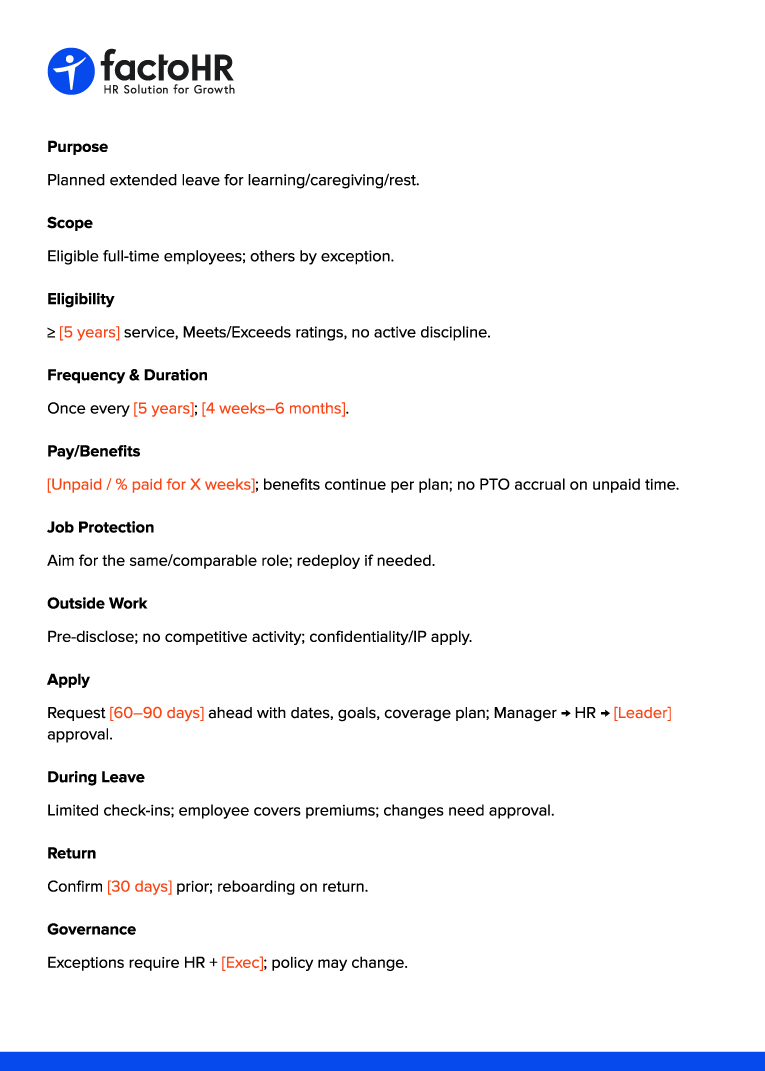Sabbatical Leave Policy Template
Table of Contents
Our Sabbatical Leave Policy template the guidelines and procedures for granting extended leave to eligible employees. This policy supports employee rejuvenation, innovation, and personal growth while ensuring job security and continuity. It applies to long-term employees and includes eligibility criteria, duration, application processes, and expectations for approval or denial of sabbatical requests. By clearly defining these elements, we aim to create a structured and fair approach that benefits both employees and the organization. This article helps you with a comprehensive template for your sabbatical leave policy in India draft.
This Sabbatical Leave Policy Should Contain
- Eligibility parameters that qualify one to have sabbatical leave.
- Duration of the sabbatical.
- The frequency of taking sabbaticals.
- Status relating to payment during leave (paid or unpaid).
- Explain scenarios where sabbaticals are acceptable.
- Application and approval process, notice period, and decision-making authority.
- Job security and post-sabbatical return to work terms.
- If the benefits are continued or discontinued during the leave.

Sabbatical Leave Policy Format

Download Sabbatical Leave Policy In India

Sabbatical Leave Policy Template
Here is a template you can use for a sabbatical leave policy draft.
Policy Overview
At [Company Name], we understand the importance of promoting personal and professional development for our employees, preventing burnout, and recognizing long-term commitment. Our Sabbatical Leave Policy offers qualified employees the opportunity to take an extended leave of absence. This time can be used for relaxation, personal growth, research assignments, volunteering, traveling, or any other personal pursuits.
Sabbaticals do not rule out vacation, PTO, and sick leaves; instead, they are provided by the company, based on the qualifications and the requirements of the business.
Scope and Eligibility
This policy extends to full-time employees who have served at least [five consecutive years] with [Company Name].
Other eligibility requirements are:
- A record of satisfactory performance and conduct.
- No previous disciplinary action within the past 12 months.
- Approval from the employee’s manager and HR.
- This type of leave can be taken after every [five years].
Duration and Compensation
The eligible employees may request a sabbatical lasting between 4 and 12 weeks. The leave time should be negotiated and taken individually.
- Sabbaticals not exceeding [6 weeks] can be 100% paid.
- Any sabbaticals that exceed 6 weeks could be paid or unpaid at the discretion of the firm.
- PTO is not accrued by employees who are on an unpaid sabbatical.
Purpose of Sabbatical
Sabbatical leave encourages revitalization and professional development. Employees are free to participate in educational courses, research projects, volunteer work, or any other activities that add value during this period.
Application and Approval Procedure.
Employees should provide a written request for sabbatical leave to the manager at least [two months] before the desired start date. The requests will be reviewed by managers depending on the business requirements, staffing, and eligibility.
Job Protection and Benefits
Employees will retain their position, along with the benefits outlined in their contract and their seniority, while on sabbatical leave. The continuation of health insurance and other benefits will follow company policy. Upon returning, employees will be reinstated to their previous job roles or similar positions.
Working while on Sabbatical
During a sabbatical, employees can engage in volunteer or other professional work, but should not do so for a competitor or use organizational resources to achieve personal interests. Any research or innovation in the line of work should be revealed based on the company’s policies.
Equipment and Expenses
Employees will be allowed to keep work equipment during the period of sabbatical. Reimbursement of training costs is based on the company’s standard training budget. All other costs involved in a sabbatical are payable by the employee.
Limitations
Sabbatical leave cannot be accrued or carried over and must be used during the eligibility period. Misuse of the sabbatical policy may result in disciplinary actions.

What are the Benefits of Sabbatical Leave Policy?
There are multiple benefits of having a Sabbatical Leave Policy for both employers and employees. To employees, it enables them to take time to rest, pursue personal and professional development, and return to work highly enthusiastic and creative.
To employers, sabbatical leaves increase retention and loyalty and improve innovation, as employees return to work with more motivation. This creates a good image of the organization as a caring and progressive workplace. It also helps determine whether sabbatical leave is paid or unpaid.
With only 6.6% of organizations offering paid sabbaticals, this becomes a key element of the policy. Here is a clear bifurcation of the benefits of Sabbatical Leave Policy for employees and employers in a table format:
| Benefits for Employees | Benefits for Employers |
|---|---|
| Gives a long break to ease stress and avoid burnout, which improves mental and physical health. | Improves retention of employees; a reward of loyalty and minimizes turnover expenses. |
| Provides the chance to grow individually, enhance skills, and reflect on the profession. | Enhances productivity and creativity, as employees return to work revitalized. |
| Enables an improved work-life balance that allows time to spend with family, traveling, or studying. | Favors succession planning as it allows others to rise to the occasion when the employees are away. |
| Improve job satisfaction and engagement by understanding the needs of the employees. | Develops a good employer brand where they are able to recruit the best talent with good benefits. |
Closing Notes
The sabbatical leave policy offers advantages for both employees and companies. Employees have the opportunity to relax and pursue personal development, while businesses benefit from having rejuvenated and committed staff members. It is important to establish a clear sabbatical policy. This guide outlines essential factors, including eligibility criteria and how to ensure a smooth transition for employees returning from their sabbatical.
A well-structured sabbatical policy benefits companies aiming for satisfied employees and fresh ideas. It retains valuable personnel and enhances the work environment. We recommend contemplating and starting a sabbatical program in your company to yield significant benefits.
What is a Sabbatical Leave?
Sabbatical leave allows an employee to take time off from work, often for a short period of time ranging from a few months to a year. This is the time to rejuvenate and grow as a person or professionally.
What is a Sabbatical Leave Policy in India?
Sabbatical Leave Policy in India refers to a policy that a company applies formally to enable employees to have a long leave period during which they are not engaged in any job-related activities, but they are still considered employees of the company.
Why is a Sabbatical Leave Policy Important?
It allows avoiding burnout, promoting work-life balance, and improving the level of engagement by allowing employees to have time and work on developing themselves.
What Should a Sabbatical Leave Policy Include?
The policy is to define eligibility, term, application, approval, remuneration, and conditions of returning to work after the sabbatical.
Can Employees Work Elsewhere during Their Sabbatical?
Unless limited by company rule, employees can conduct other businesses or activities and not work with competitors or a non-competitor non-compete agreement.
Why Should Companies Offer Sabbatical Leave Programs?
Sabbatical leave policy reduces burnout in the workforce. They enhance motivation, skill acquisition, development, and work-life balance. Such programs lead to a refreshed workforce, increased creativity, high employee morale, and a high retention rate.
Who is Eligible for a Sabbatical Leave?
This will usually depend on the employee’s tenure and performance evaluations. To qualify, an employee must have served the company for a certain number of years, usually one to five years, and must have received good evaluation reports.
What are the Benefits of Offering a Leave Policy?
Employing time off can help workers avoid burnout, enhance motivation, and cultivate skills. It can also ignite creativity, elevate morale, and minimize turnover.
Disclaimer
This Sabbatical Leave Policy Template is aimed at providing an outline on which organizations can build their policies. It might not be representative of all the local, state, or federal laws and must be examined and modified to fulfill specific legal requirements and organizational purposes. The author and factoHR Team will not be held responsible for any consequences resulting from its use.
Transform your HR operations with factoHR today
Choose a perfect plan satisfying your business demands and let factoHR handle all your HR’s tasks efficiently.

© 2026 Copyright factoHR


